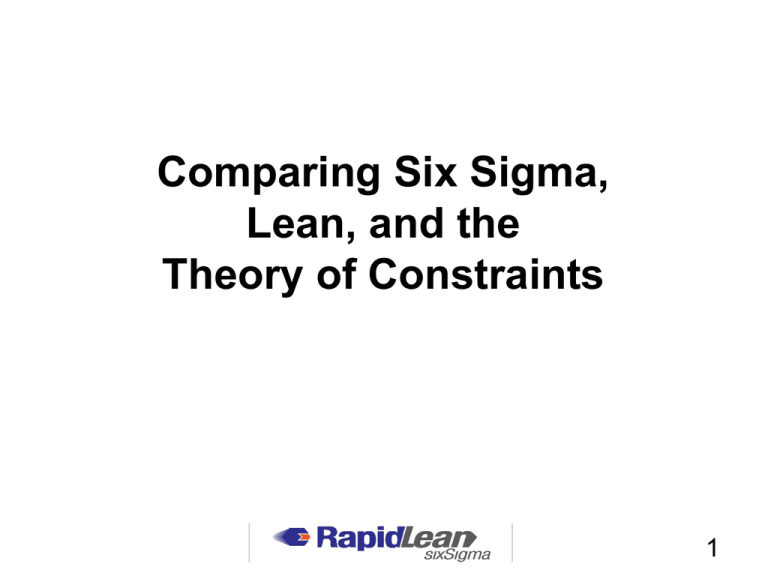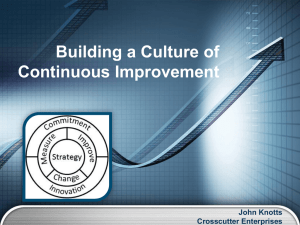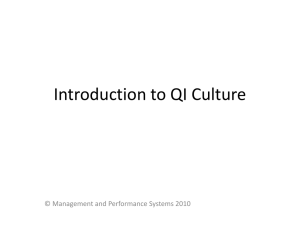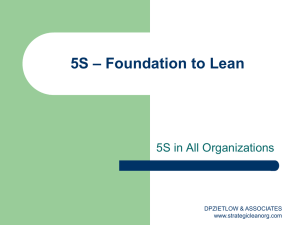BCP Training Strategy.Oveview
advertisement

Comparing Six Sigma, Lean, and the Theory of Constraints 1 Six Sigma 2 Six Sigma claims that focusing on reduction of variation will solve process and business problems. By using a set of statistical tools to understand the fluctuation of a process, management can begin to predict the expected outcome of that process. If the outcome is not satisfactory, associated tools can be used to further understand the elements influencing that process. 3 Through a rigid and structured investigation methodology, the process elements are more completely understood. The assumption is the outcome of the entire process will be improved by reducing the variation of multiple elements. 4 Six Sigma problem solving methodology includes five steps: define, measure, analyze, improve and control (commonly known as DMAIC): 5 Lean History of Lean 6 Lean thinking is sometimes called lean manufacturing, the Toyota production system or other names. Lean focuses on the removal of waste, which is defined as anything not necessary to produce the product or service. 7 There are five essential steps in lean: 1. Identify which features create value. 2. Identify the sequence of activities called the value stream. 3. Make the activities flow. 4. Let the customer pull product or service through the process. 5. Perfect the process. 8 Theory of Constraints (TOC) 9 Theory of Constraints (TOC) TOC focuses on system improvement. A system is defined as a series of interdependent processes. An analogy for a system is the chain: a group of interdependent links working together toward the overall goal. The constraint is a weak link. 10 Theory of Constraints (TOC) The performance of the entire chain is limited by the strength of the weakest link. In manufacturing processes, TOC concentrates on the process that slows the speed of the process. 11 Theory of Constraints (TOC) TOC consists of five steps: 1. Identify the constraint. 2. Exploit the constraint. 3. Subordinate other processes to the constraint. 4. Elevate the constraint. 5. Repeat the cycle. 12 Agile Manufacturing 13 Agile Manufacturing Many practitioners are dismissive of Agile Manufacturing “as a patchwork of plausible concepts and methods.” In manufacturing, it is dead. The term is still used in software development and project management. 14 Agile Manufacturing Roger Nagel’s team at Lehigh borrowed the registered service mark “Agile Enterprise” … from Crispin Vincenti-Brown and Ingersoll Engineers. Their Agile Enterprise was a manufacturing company with production organized in their version of cells, grouped in focused factories, as defined by Wickham Skinner. 15 Business Process Reengineering (BPR) 16 Business Process Reengineering (BPR) Business Process Reengineering (BPR), after a burst of popularity in the 1990s, is now a gentler version called “Business Process Management” (BPM). The differences between the two are explained in a blog post by Sweeta Anand. BPR failed in the market because the employees of companies that tried to implement it perceived it as a threat, before its technical shortcomings ever had a chance to appear. 17 Business Process Reengineering (BPR) BPR is not about manufacturing but about business in general, and is predicated on the assumption that any business can be structured as a family of processes, characterized entirely by the outputs they generate and the inputs they use. In the BPR perspective, R&D is a process with product designs as output. Manufacturing, on the other hand, is not a process but is instead subsumed under order fulfillment. BPR takes Wickham Skinner’s focused factory or Womack and Jones’s value stream and expands it to all business activities. BPR is intended to break down the functional silos that make bureaucracies slow and unresponsive and replace them with process-aligned structures that are focused on their useful outputs. 18 Business Process Reengineering (BPR) According to the founding fathers of BPR, Michael Hammer and James Champy, part of the definition of a process is that its output must be “of value to the customer,” but what is meant by customer is ambiguous. Technically, BPR is simplistic, but it’s not the reason it failed. What is absent from the BPR literature is any consideration of the people doing the work and what happens to them as a result of reengineering. In manufacturing, Lean improves performance, the company grows, and the people freed up by productivity increases are used to support the growth, and it is essential to the success of the approach that operators not be putting their jobs in jeopardy by participating. BPR, on the other hand, simply reengineered people’s jobs away, which, predictably, resulted in mutinies. 19 Total Quality Management (TQM) 20 Total Quality Management (TQM) TQM is an integrative philosophy of management for continuously improving the quality of products and processes. TQM is based on the premise that the quality of products and processes is the responsibility of everyone involved with the creation or consumption of the products or services which are offered by an organization, requiring the involvement of management, workforce, suppliers, and customers, to meet or exceed customer expectations. 21 TQM TQM, as a watered-down version of the Japanese TQC, became the object of the Malcolm Baldridge National Quality Award in the US in 1988, and soon lost credibility as a result of being given to organizations that were notorious for bad quality. The spirit of TQM, however, lives on in the ISO-900x series of standards, for which certification has been a cost of doing business for many companies. 22 Lean Six Sigma 23 Lean Six Sigma Lean Six Sigma is a managerial concept combining Lean and Six Sigma that results in the elimination of waste / muda. The Lean Six Sigma concepts were first published in the book titled Lean Six Sigma: Combining Six Sigma with Lean Speed by Michael George in 2002. 24 Lean Six Sigma Lean Six Sigma utilizes the DMAIC phases similar to that of Six Sigma. The DMAIC toolkit of Lean Six Sigma comprises all the Lean and Six Sigma tools. The training for Lean Six Sigma is provided through the belt based training system similar to that of Six Sigma. The belt personnel are designated as white belts, yellow belts, green belts, black belts and master black belts. 25 Lean Six Sigma 26 Rapid-Lean 27 RapidLeanSixSigma A common complaint of traditional Lean and Six Sigma is that they “take too long.” Success of RapidLeanSixSigma depends on: speed, simplicity, and boldness. 28 Rapid-Lean RapidLeanSixSigma provides the tools and techniques for making decisions and solving problems - fast. An organization’s early success will be realized through engaged employees using an empowered approach for “rapid” process improvement. 29 RapidLeanSixSigma Integrating Lean and Six Sigma Speed and Simplicity Lean • Waste Reduction • Velocity Six Sigma • Problem Solving Methodology 30 In short, How an organization adds value. 31 More Broadly, Three Big Questions 1. Where are we now? 2. Where do we want to go? 3. How do we get there? 32 Quality function deployment and value management are two techniques used to help connect the product or service design to customer needs. Both bring marketing, finance, operations, design, customer and suppliers together to systematically explore how the product performs the function the customer needs. An interesting part of this investigation is that cost can be associated with function. When marketing and customers know the cost of specific features, they make informed choices about the 33 34 Parking Lot 35 36 Value chain coordinated series or sequence of functional activities necessary to transform inputs into finished goods or services customers value and want to buy 37 Value-chain management development of a set of functional-level strategies that support a company’s businesslevel strategy and strengthen its competitive advantage 38 “To try and fail is at least to learn; to fail to try is to suffer the inestimable loss of what might have been.” Chester Barnard (former CEO of New Jersey Bell Telephone) 39 Successful Implementation 1. 2. 3. 4. 6. 7. Build organizational commitment Focus on the customer Set goals and create incentives Solicit input from employees Identify opportunities for improvement Break down barriers between functions 40 1. Identify what customers want from the good or service provided 2. Identify what is actually provided to customers 3. Identify the gap that exists between what the customers want and what they get (quality gap) 4. Formulate a plan for closing the quality gap 41 Benefits Delighted Customers Benchmarking against best practices Identifying the right things Teamwork by committed employees. 42 www.johnbesaw.com 43









